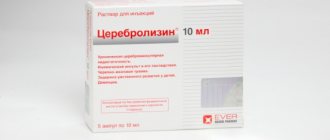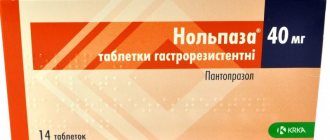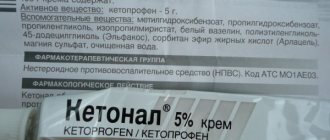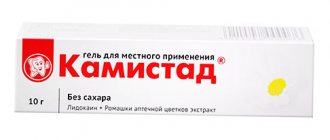Azaran is a drug that belongs to the group of third-generation cephalosporin antibiotics. It differs from other antibacterial agents in its wide spectrum of action. Azaran is administered intravenously and intramuscularly - no other methods of treatment are provided.
The main effect of Azaran is bactericidal, with its help it is possible to quickly suppress the division of pathogenic microorganisms. The essence of the effect is to disrupt the structure of cell walls, due to which the strength and rigidity of cells is reduced.
The powder can be used to treat bacteria that produce beta-lactamase, a substance that protects gra-positive and gram-negative microorganisms.
Pharmacodynamics
Azaran is a medicine that has a powerful bactericidal effect.
It works by suppressing the production of substances that build the bacterial cell wall. Due to this, such a formation begins to gradually die, and the person begins to feel relief. Keep in mind that the drug is quite powerful - it can only be prescribed after consultation with a qualified physician.
Azaran is usually used to treat infection:
- Gram-positive aerobes such as Staphylococcus epidermidis or Streptococcus pneumoniae;
- Gram-negative aerobes - strains that form beta-lactamases, such as Haemophilusducreyi, Haemophilusinfluenzae;
- Strains that produce penicillinase;
- Anaerobes.
It should be borne in mind that Azaran is not used to treat all types of bacteria. It is completely ineffective for treating strains that are resistant to methicillin: Enterococcus spp, Clostridium difficile, as well as those that produce beta-lactamases. These substances make microorganisms resistant to the influence of ceftriaxonase.
Pharmacological properties of the drug Azaran
Has bactericidal and antibacterial effects. It has a wide range of effects.
It comes in the form of bottles containing powder intended to create a solution.
Pharmacodynamics
The bactericidal effect occurs as a result of blocking the activity of bacteria and inhibiting the synthesis of microbial cells.
Resistant to the action of beta-lactamases produced by most pathogenic bacteria.
Pharmacokinetics
After intramuscular administration, it is absorbed in a short time. Bioavailability reaches 100%. It has the ability to pass into the tissues and fluids of the body, in particular into the respiratory and abdominal organs, urinary tract, bones, joints and tendons, skin, subcutaneous tissue, and cerebrospinal fluid.
The concentration of the drug becomes stable within 3-4 days. The half-life depends on the age of the patient. In newborns, the elderly and people with impaired kidney and liver function, the process slows down. In adult patients, 50-60% is excreted through the kidneys and 40-50% through bile.
Pharmacokinetics
Azaran is a powder for administration inside the body. After entering muscle tissue, it is able to quickly dissolve and be almost completely absorbed. Statistics show that its availability is almost complete. The active components are able to quickly penetrate tissues and internal fluids; a certain concentration of the drug is determined in the joints, bones, subcutaneous tissue, respiratory tract and abdominal organs.
Within 4 days, a stable concentration is observed in the body. The maximum dose appears 2-3 hours after administration.
It should be borne in mind that the active components of Azaran can rapidly penetrate into the cerebrospinal fluid. However, this occurs only during an inflammatory process that occurs in the meninges. Studies have shown that after 22-24 hours, the concentration of the active substances of the drug in the cerebrospinal fluid is several times greater than the number of viruses. The effect of the drug lasts on average 6-9 hours, so it is taken only once a day.
Keep in mind that the active components are able to bind to plasma albumin, due to which they rapidly spread throughout the body. The volume of distribution of active ingredients averages about 0.12-0.14 liters/kg. If Azaran is used in the elderly, their half-life increases significantly.
In addition, such changes also affect children with liver and kidney problems. All substances are eliminated from the body within a few days - after 2 days only half of them are removed. Keep in mind that hemodialysis is not able to reduce the concentration of active substances.
Release form and composition
The dosage form of Azaran is a powder for the preparation of a solution for intravenous and intramuscular administration: a powdery mass from white with a yellowish tint to white (1.0 g each in colorless glass bottles, sealed with a combined cap made of plastic, rubber and metal, with a first-opening control function ; 1, 10 or 50 bottles in a cardboard box).
1 bottle contains the active ingredient: ceftriaxone sodium (in terms of ceftriaxone) – 1.0 g.
Indications for use
Azaran is a drug that has a powerful bactericidal effect. It is used for the treatment of infectious and inflammatory diseases. It is important that pathogenic microorganisms are not resistant to a specific virus.
Most often this powder is used to treat:
- Infectious lesions of bone tissue and joints;
- Bacterial infection of the skin;
- Soft tissue infections;
- Pneumonia, pleural empyema, lung abscess;
- Pyelonephritis and other urinary tract infections;
- Blood poisoning;
- Gonorrhea and other sexually transmitted diseases;
- Salmonellosis, shigellosis, Lyme disease;
- Endocarditis, bacterial meningitis;
- Infectious infection of the gastrointestinal tract;
- Lesions of the gallbladder - cholangitis, empyema of the gallbladder, peritonitis;
- Infections in the pelvis;
- As a prophylaxis against infection after surgery.
Azaran price
On the websites below you can find prices for Azaran and find out about availability at a pharmacy near you
Azaran instructions
INSTRUCTIONS for using the drug Azaran
Release form: Powder for solution for injection
Composition: 1 bottle contains ceftriaxone (in the form of ceftriaxone disodium trisesquihydrate) - 1 g
Packaging 10 pcs.
Pharmacological action Azaran is a third generation cephalosporin antibiotic with a broad spectrum of action for parenteral administration. It has a bactericidal effect, inhibiting the synthesis of the cell membrane of microorganisms. Acetylates membrane-bound transpeptidases, thereby disrupting the cross-linking of peptidoglycans necessary to ensure the strength and rigidity of the cell wall.
Azaran, indications for use Treatment of infectious and inflammatory diseases caused by sensitive microorganisms: – infections of the upper and lower respiratory tract (including pneumonia, lung abscess, pleural empyema); – infections of the skin and soft tissues; – infections of bones and joints;
– urinary tract infections (including pyelonephritis); – infections of the abdominal organs, inflammatory diseases of the gastrointestinal tract, biliary tract (including cholangitis, empyema of the gallbladder); – infections of the pelvic organs; – peritonitis; – sepsis; – bacterial meningitis;
Contraindications Hypersensitivity to ceftriaxone and other cephalosporins, penicillins.
Use during pregnancy and breastfeeding The use of Azaran during pregnancy is possible only in cases where the expected benefit to the mother outweighs the potential risk to the fetus (ceftriaxone penetrates the placental barrier). If it is necessary to use Azaran during lactation, the issue of stopping breastfeeding should be decided (ceftriaxone is excreted with breast milk).
nausea, vomiting, taste disturbance, flatulence, stomatitis, glossitis, diarrhea, pseudomembranous enterocolitis, pseudocholelithiasis, dysbiosis, increased activity of liver transaminases and alkaline phosphatase, hyperbilirubinemia. From the urinary system: oliguria, hypercreatininemia, increased urea content, glucosuria, hematuria.
From the hematopoietic system: anemia, leukopenia, leukocytosis, lymphopenia, neutropenia, granulocytopenia, thrombocytopenia, thrombocytosis, basophilia. From the blood coagulation system: nosebleeds, hemolytic anemia, increase (decrease) in prothrombin time.
Special instructions With caution, Azaran is prescribed for nonspecific ulcerative colitis, for impaired liver and kidney function, for enteritis and colitis associated with the use of antibacterial drugs. The drug is used only in medical institutions. With simultaneous severe renal and hepatic failure, patients on hemodialysis should be regularly determined concentration of ceftriaxone in blood plasma.
Storage conditions Store in a dry place, protected from light at a temperature of 15° to 25°C.
Shelf life: 3 years.
Mode of application
Azaran is a medicine available in powder form. After dissolution, it is intended for intramuscular and intravenous administration. Moreover, it can be drip or jet.
The drug is usually administered once a day - it has a prolonged effect, making more frequent use inappropriate.
When determining a treatment regimen, it is recommended to adhere to the information provided by the manufacturer:
| Indication | Patient group | Recommended dose, mg/kg | Maximum possible dose, mg/kg |
| Uncomplicated infectious process | Newborns and children up to 14 days | 20-50 | 50 |
| Children under 12 years old | 20-80 | 100 | |
| Adults | 1000-2000 | 4000 | |
| Prevention of infectious processes after operations | Everyone | 1000-2000 | 4000 |
| Bacterial meningitis | For infants and young children | 100 | 4000 |
| Acute gonorrhea in uncomplicated form | For adults | 250 | 500 |
| Lyme disease | For adults and children | 50 | 2000 |
Azaran: drug Azaran instructions for use
Azaran release form, composition and packaging
Powder for solution for injection is white to yellowish-white.
1 fl. ceftriaxone (in the form of ceftriaxone disodium trisesquihydrate) 1 g.
Clinical and pharmacological group: III generation cephalosporin.
The drug Azaran pharmacological action
Broad-spectrum cephalosporin antibiotic of the third generation for parenteral administration. It has a bactericidal effect, inhibiting the synthesis of bacterial cell walls. Acetylates membrane-bound transpeptidases, thereby disrupting the cross-linking of peptidoglycans necessary to ensure the strength and rigidity of the cell wall. Resistant to β-lactamases produced by most gram-positive and gram-negative bacteria.
Active against gram-positive aerobic bacteria: Staphylococcus aureus, Staphylococcus epidermidis, Streptococcus pneumoniae, Streptococcus pyogenes, Streptococcus agalactiae, Streptococcus viridans, Streptococcus bovis; gram-negative aerobic bacteria: Aeromonas spp., Alcaligenes spp., Branhamella catarrhalis (including strains that form β-lactamases), Citrobacter spp., Enterobacter spp., (some strains are resistant), Escherichia coli, Haemophilus ducreyi, Haemophilus influenzae (including strains producing penicillinase), Haemophilus parainfluenzae, Klebsiella spp. (including Klebsiella pneumoniae), Moraxella spp., Morganella morganii, Neisseria gonorrhoeae (including penicillinase-producing strains), Neisseria meningitidis, Plesiomonas shigelloides, Proteus mirabilis, Proteus vulgaris, Providencia spp., Salmonella spp. (including Salmonella typhi), Serratia spp. (including Serratia marsescens), Shigella spp., Vibrio spp. (including Vibrio cholerae), Yersinia spp. (including Yersinia enterocolitica), Pseudomonas aeruginosa (some strains); gram-negative anaerobic bacteria: Bacteroides spp. (including some strains of Bacteroides fragilis), Clostridium spp. (except Clostridium difficile), Fusobacterium spp. (except Fusobacterium mortiferum and Fusobacterium varium), Peptococcus spp., Peptostreptococcus spp.
Methicillin-resistant strains of Staphylococcus spp., strains of Enterococcus spp. are resistant to the drug. (Enterococcus faecalis), Clostridium difficile, many strains of Bacteroides spp. (producing β-lactamases).
It is not hydrolyzed by R-plasmid β-lactamases, as well as by most chromosome-mediated penicillinases and cephalosporinases, and can act on multi-resistant strains that are tolerant to penicillins and first-generation cephalosporins and aminoglycosides. The acquired resistance of some strains is due to the production of β-lactamase, which inactivates ceftriaxone (ceftriaxonase).
Azaran pharmacokinetics
Suction and distribution
After intramuscular administration, ceftriaxone is quickly and completely absorbed into the systemic circulation. Penetrates well into tissues and fluids of the body: respiratory tract, bones, joints, urinary tract, skin, subcutaneous tissue and abdominal organs. In case of inflammation of the meningeal membranes, it penetrates well into the cerebrospinal fluid. The bioavailability of ceftriaxone with intramuscular administration is 100%. After intramuscular administration, Cmax is reached after 2-3 hours, with intravenous administration - at the end of the infusion.
With intramuscular administration of ceftriaxone at a dose of 500 mg and 1 g, Cmax in blood plasma is 38 µg/ml and 76 µg/ml, respectively, with intravenous administration at a dose of 500 mg, 1 g and 2 g - 82 µg/ml, 151 μg/ml and 257 μg/ml, respectively. In adults, 2-24 hours after administration of the drug at a dose of 50 mg/kg, the concentration in the cerebrospinal fluid is many times higher than the MIC for the most common pathogens of meningitis. An equilibrium state is established within 4 days of drug administration.
Reversible binding to plasma proteins (albumin) is 83–95%. Vd is 5.78-13.5 l (0.12-0.14 l/kg), in children - 0.3 l/kg.
Removal
T1/2 is 6-9 hours. Plasma clearance is 0.58-1.45 l/h, renal clearance is 0.32-0.73 l/h. In adult patients, within 48 hours, 50-60% of the drug is excreted unchanged by the kidneys, 40-50% is excreted with bile into the intestines, where it is biotransformed into an inactive metabolite.
Pharmacokinetics in special clinical situations
In newborns, about 70% of the drug is excreted through the kidneys. In newborns and the elderly (over the age of 75 years), as well as in patients with impaired renal and liver function, T1/2 increases significantly.
In patients on hemodialysis with CC 0-5 ml/min, T1/2 is 14.7 hours; with CC 5-15 ml/min - 15.7 hours; with CC 16-30 ml/min - 11.4 hours; with CC 31-60 ml/min - 12.4 hours.
In children with meningitis T1/2 after intravenous administration at a dose of 50-75 mg/kg is 4.3-4.6 hours.
Azaran indications
Treatment of infectious and inflammatory diseases caused by sensitive microorganisms:
- infections of the upper and lower respiratory tract (including pneumonia, lung abscess, pleural empyema);
- skin and soft tissue infections;
- bone and joint infections;
- urinary tract infections (including pyelonephritis);
- inflammatory diseases of the gastrointestinal tract and biliary tract (including cholangitis, empyema of the gallbladder);
- pelvic organ infections;
- peritonitis;
- bacterial meningitis;
- bacterial endocarditis;
- sepsis;
- acute and complicated gonorrhea;
- Lyme disease;
- shigellosis;
- salmonellosis.
Prevention and treatment of infectious postoperative complications.
Azaran dosage regimen
The drug is administered intramuscularly or intravenously.
For adults and children over 12 years of age, the average daily dose is 1-2 g 1 time/day. The maximum daily dose for adults is 4 g.
For newborns under 14 days of age, the dose is 20-50 mg/kg/day. The maximum daily dose is 50 mg/kg.
For children aged 15 days to 12 years, the daily dose is 20-80 mg/kg. A daily dose of more than 50 mg/kg body weight should be administered as an intravenous infusion.
The duration of the course usually does not exceed 10 days. Administration of the drug should be continued for 2-3 days after body temperature normalizes and symptoms disappear.
To prevent infections in the postoperative period, the drug is administered once 30-90 minutes before the start of surgery in a dose of 1-2 g (depending on the degree of risk of infection). During surgical interventions on the colon and rectum, additional administration of a drug from the group of 5-nitroimidazoles is recommended.
For bacterial meningitis, the daily dose is 100 mg/kg. The maximum dose is 4 g 1 time/day. The duration of therapy depends on the type of pathogen and can range from 4 days for meningitis caused by Neisseria meningitidis to 10-14 days for meningitis caused by susceptible strains of Enterobacteriaceae.
For children with skin and soft tissue infections, the drug is prescribed in a daily dose of 50-75 mg/kg body weight 1 time/day or 25-37.5 mg/kg every 12 hours, but not more than 2 g/day. For severe infections of other localization - at a dose of 25-37.5 mg/kg every 12 hours, but not more than 2 g/day. For otitis media, the drug is administered intramuscularly at a dose of 50 mg/kg body weight, but not more than 1 g. For gonorrhea, the drug is administered intramuscularly at a single dose of 250 mg.
In patients with impaired renal function, dose adjustment is required only in cases of severe renal failure (creatinine clearance less than 10 ml/min), in which case the daily dose of ceftriaxone should not exceed 2 g.
Rules for the preparation and administration of solution for injection
To prepare a solution for intramuscular injection, 1 g of the drug is dissolved in 3.5 ml of a 1% solution of lidocaine chloride. Injected deep into large muscle mass. Do not inject more than 1 g into one muscle. It should be remembered that lidocaine chloride solution cannot be administered intravenously.
To prepare a solution for intravenous administration, 1 g of the drug is dissolved in 9.6 ml of sterile water for injection. The solution is administered slowly over 2-4 minutes.
To prepare a solution for intravenous infusion, 2 g of the drug is dissolved in 40 ml of one of the solutions that do not contain calcium (0.9% sodium chloride solution, 0.45% sodium chloride solution and 2.5% dextrose, 5% dextrose solution, 10% dextrose solution , 6% dextran solution and 5% dextrose solution, 6-10% solution of hydroxyethyl starch). The duration of the IV infusion is at least 30 minutes.
Freshly prepared solutions of ceftriaxone are stable for 6 hours at room temperature and for 24 hours when stored in a refrigerator at a temperature of 2° to 8°C.
Azaran side effects
- From the side of the central nervous system: headache, dizziness.
- From the urinary system: oliguria, glucosuria, hematuria, hypercreatininemia, increased urea content.
- From the digestive system: nausea, vomiting, taste disturbance, flatulence, stomatitis, glossitis, diarrhea, pseudomembranous enterocolitis, pseudocholelithiasis (sludge syndrome), dysbacteriosis, abdominal pain, increased activity of liver transaminases and alkaline phosphatase, hyperbilirubinemia.
- From the hematopoietic system: anemia, leukopenia, leukocytosis, lymphopenia, neutropenia, granulocytopenia, thrombocytopenia, thrombocytosis, basophilia, hemolytic anemia.
- From the blood coagulation system: nosebleeds, increase (decrease) in prothrombin time.
Allergic reactions: urticaria, rash, itching, exudative erythema multiforme, fever, edema, eosinophilia, anaphylactic shock, serum sickness, bronchospasm.
Other: superinfection (including candidiasis).
Local reactions: with intravenous administration - phlebitis, pain along the vein; with intramuscular injection - pain at the injection site.
Azaran contraindications
- hypersensitivity to ceftriaxone and other cephalosporins, penicillins and carbapenems.
The drug is prescribed with caution in case of impaired liver and/or kidney function (the likelihood of accumulation requires monitoring the concentration of the drug in the serum), premature and newborn children with hyperbilirubinemia (there is a possibility of increased side effects), with nonspecific ulcerative colitis, as well as with enteritis or colitis associated with the use of antibacterial drugs.
The drug Azaran during pregnancy and lactation
The use of Azaran during pregnancy is possible only in cases where the expected benefit to the mother outweighs the potential risk to the fetus (ceftriaxone crosses the placental barrier).
If it is necessary to use Azaran during lactation, the issue of stopping breastfeeding should be decided (ceftriaxone is excreted in breast milk).
Use for liver dysfunction
In patients with impaired liver function, T1/2 increases significantly.
Use for renal impairment
In patients with impaired renal function, dose adjustment is required only in cases of severe renal failure (creatinine clearance less than 10 ml/min), in which case the daily dose of ceftriaxone should not exceed 2 g.
Azaran special instructions
The drug is used only in a hospital setting. With simultaneous severe renal and liver failure in patients on hemodialysis, the concentration of ceftriaxone in the blood plasma should be regularly determined.
With long-term treatment, it is necessary to regularly monitor the peripheral blood picture, indicators of the functional state of the liver and kidneys.
In rare cases, an ultrasound of the gallbladder reveals dark spots that disappear after discontinuation of the drug (even if this phenomenon is accompanied by pain in the right hypochondrium, it is recommended to continue prescribing the antibiotic and carrying out symptomatic treatment).
When using the drug, you should not consume ethanol, because the development of disulfiram-like effects is possible (redness of the face, cramping pain in the abdomen and stomach area, nausea, vomiting, headache, decreased blood pressure, tachycardia, shortness of breath).
While using Azaran, elderly and debilitated patients may require vitamin K.
Azaran drug overdose
Currently, no cases of overdose of Azaran have been reported. Hemodialysis is not effective for removing the drug from the body.
Asaran drug interactions
Ceftriaxone and aminoglycosides are synergistic against many gram-negative bacteria. When used together with NSAIDs and other antiplatelet agents, the likelihood of bleeding increases.
When used simultaneously with loop diuretics and other nephrotoxic drugs, the risk of nephrotoxicity increases.
Pharmaceutical interactions
Pharmaceutically incompatible with solutions containing other antibiotics.
Azaran storage conditions and periods
List B. The drug should be stored out of the reach of children, in a dry place, protected from light at a temperature of 15° to 25°C. Shelf life: 3 years.
You might be interested in:
- Contour plastic with fillers
- How to treat caries in children: advice from medical...
- Who invented the beanbag chair?
- Industrial equipment: what is more profitable - rent or...
Contraindications
Azaran is a drug that has undergone many clinical studies. Despite its safety and gentle effect on the body, it cannot always be used.
Contraindications include:
- Hypersensitivity to the components of the drug;
- Hyperbilirubinemia;
- Nonspecific ulcerative colitis;
- Colitis and enteritis resulting from antibiotic therapy.
Overdose
Overdose from the use of Azaran occurs extremely rarely. Since the medicine is intended for use in an outpatient setting, the dose of the medicine is always calculated correctly.
If you are given a large amount of the drug, all the side effects will soon worsen. There is no clear antidote for this condition; symptomatic therapy is carried out. Hemodialysis does not prevent overdose.
Pregnancy
Application
during pregnancy is possible only in cases where the expected benefit to the mother outweighs the potential risk to the fetus (ceftriaxone crosses the placental barrier).
If it is necessary to use Azaran during lactation, the issue of stopping breastfeeding should be decided, because
Ceftriaxone is excreted in breast milk.
Side effects
Azaran is a fairly safe drug that rarely causes side effects. To reduce the likelihood of their occurrence, you should always follow your doctor’s recommendations and adhere to the instructions for use.
Some of the most common consequences of improper administration or intolerance include:
- General malaise, dizziness, headache, loss of coordination and orientation in space;
- Nausea, vomiting, abdominal cramps, diarrhea, constipation;
- Increased amount of bilirubin and liver enzymes in the blood;
- Stomatitis, glossitis, anuria, oliguria;
- Impaired metabolism of nitrogenous products, the appearance of glucose and blood in the urine;
- The appearance of superinfections, the development of thrush;
- Pain in the blood vessels, the formation of small blood clots;
- Allergic reaction, itching, increased body temperature, spasm in the bronchi;
- Opening of nosebleeds, blood clotting disorders, decreased levels of plasma factors;
- Increased platelet count, slowed blood clotting.
Similar drugs:
- Augmentin Oral tablets
- Tea tree DN Ointment for external use
- Augmentin Powder for suspension for oral administration
- Bactrim Oral suspension
- Dioxydin Mouth rinse solution
- Pancef Oral tablets
- Nifuroxazide (Nifuroxazide) Oral tablets
- Cifran OD Oral tablets
- Pancef Granules for the preparation of suspension for oral administration
- Augmentin ES Powder for oral solution
** The Drug Directory is intended for informational purposes only. For more complete information, please refer to the manufacturer's instructions. Do not self-medicate; Before starting to use the drug Azaran, you should consult a doctor. EUROLAB is not responsible for the consequences caused by the use of information posted on the portal. Any information on the site does not replace medical advice and cannot serve as a guarantee of the positive effect of the drug.
Are you interested in the drug Azaran? Do you want to know more detailed information or do you need a doctor's examination? Or do you need an inspection? You can make an appointment with a doctor - the Euro lab is always at your service! The best doctors will examine you, advise you, provide the necessary assistance and make a diagnosis. You can also call a doctor at home . Euro lab clinic is open for you around the clock.
** Attention! The information presented in this medication guide is intended for medical professionals and should not be used as a basis for self-medication. The description of the drug Azaran is provided for informational purposes and is not intended for prescribing treatment without the participation of a doctor. Patients need to consult a specialist!
If you are interested in any other drugs and medications, their descriptions and instructions for use, information about the composition and form of release, indications for use and side effects, methods of use, prices and reviews of drugs, or you have any other questions and suggestions - write to us, we will definitely try to help you.
special instructions
Azaran is a drug whose use requires compliance with a number of rules. It is used exclusively in a hospital setting and should only be administered by qualified personnel.
For people suffering from severe kidney failure, the daily dose should not exceed 2 grams. If the patient has renal or liver failure, the specialist needs to adjust the dose based on the individual characteristics of the body.
Drug interactions
Azaran is a medicine that can be used in combination with other medicines. In this case, you should adhere to a number of rules.
Among the most important:
- When Azaran is used together with aminoglucosides, the effectiveness of treating gram-negative bacteria is significantly increased. However, they must be used separately and in doses prescribed by the attending physician;
- Azaran interferes with the production of vitamin K, which may require additional therapy.
- The active components of the drug disrupt the intestinal microflora;
- Drugs that reduce platelet production are discontinued during treatment with Azaran - their combination increases the risk of bleeding;
- With the simultaneous use of this antibiotic with anticoagulants, the effectiveness of the latter increases significantly;
- Simultaneous therapy with Azaran and nephrotoxic drugs increases the pathogenic effects of the latter;
- It is strictly forbidden to use Azaran with solutions that contain other antibiotics or fluconazole;
- Azaran is not dissolved in medications that contain calcium.
How to find a cheap analogue of an expensive medicine?
To find an inexpensive analogue of a medicine, a generic or a synonym, first of all we recommend paying attention to the composition, namely the same active ingredients and indications for use. The same active ingredients of a drug will indicate that the drug is a synonym for the drug, pharmaceutically equivalent or a pharmaceutical alternative.
However, we should not forget about the inactive components of similar drugs, which may affect safety and effectiveness. Do not forget about the instructions of doctors; self-medication can harm your health, so always consult a doctor before using any medication.
Precautionary measures
In order for the use of Azaran to bring extremely positive results, it is necessary to adhere to a number of certain rules. First of all, they concern patients suffering from renal and liver failure. Such patients need to constantly monitor the level of active substances in the blood.
In addition, with prolonged use of the drug, liver and kidney function indicators, as well as the concentration of other peripheral blood components, should be constantly monitored.
With prolonged use of the medicine, ultrasound diagnostics may show the presence of darkening in the gallbladder. This does not require special treatment - the disorder goes away on its own after some time.
In rare cases, long-term use causes pain in the area of the ribs and shoulder blades. Therapy is not canceled because of this; it is supplemented with symptomatic therapy.
While using Azaran, it is strictly forbidden to take ethanol - the risk of developing side effects increases significantly: decreased blood pressure, nausea, vomiting, facial redness, abdominal pain. For weakened patients, therapy is supplemented with the use of vitamin K.
Interaction with other drugs
- Aminoglycosides - act synergistically with ceftriaxone against many gram-negative bacteria (including Pseudomonas aeruginosa), they must be administered separately in recommended doses;
- Drugs that reduce platelet aggregation (nonsteroidal anti-inflammatory drugs, sulfinpyrazone, salicylates) - ceftriaxone suppresses the intestinal flora, interfering with the synthesis of vitamin K, thereby increasing the risk of bleeding;
- Anticoagulants – their anticoagulant effect is enhanced;
- “Loop” diuretics and other nephrotoxic drugs – the risk of their nephrotoxic effect increases;
- Ethanol - Azaran is incompatible with products containing alcohol;
- Solutions containing other antibiotics (including aminoglycosides and vancomycin) and solutions containing fluconazole are pharmaceutically incompatible with Azaran;
- Solutions containing calcium (including Ringer's solution) should not be mixed with ceftriaxone.
Ceftriaxone and aminoglycosides have synergism against many gram-negative bacteria (including Pseudomonas aeruginosa); the drugs should be administered separately in recommended doses.
Ceftriaxone, by suppressing intestinal flora, interferes with the synthesis of vitamin K. Therefore, when used simultaneously with drugs that reduce platelet aggregation (NSAIDs, salicylates, sulfinpyrazone), the risk of bleeding increases.
When used simultaneously with anticoagulants, an increase in the anticoagulant effect is observed.
When used simultaneously with loop diuretics and other nephrotoxic drugs, the risk of nephrotoxicity increases.
The drug is incompatible with ethanol.
Pharmaceutically incompatible with solutions containing other antibiotics (including vancomycin and aminoglycosides) and with solutions containing fluconazole.
Ceftriaxone should not be mixed with solutions containing calcium (including Ringer's solution).
In Latin - Azaran.
The drug belongs to the group of cephalosporins.
Azaran is an improved antibacterial agent based on ceftriaxone.
Reviews
Marina, 34 years old “I recently bought stewed meat in one of the stores near my house. My husband really loves navy pasta, and from time to time I cook it for the whole family. The dish, as always, turned out excellent, but literally the next morning we all began to feel seriously unwell. We immediately thought it was a cold, but it kept getting worse and worse. Over time, the discomfort became so strong that we didn’t even have any doubts about whether to call an ambulance. We were immediately taken to the hospital, examined and diagnosed with salmonellosis. It turned out that this stew was contaminated. We were given injections with Azaran for quite a long time, but such therapy allowed us to avoid serious complications.”
Victor, 39 years old “After traveling to Africa, for my own safety, I decided to undergo an extensive diagnostic examination. It showed that I had an infection in my bones. As luck would have it, the first signs began to develop rapidly as soon as my problem was discovered. The doctor prescribed Azaran. I took it for several weeks. I want to say that after just a few uses I felt noticeably better. During the therapy, I did not experience any side effects; the use left me with only positive emotions.”
Alexander, 44 years old “I don’t know why, but I never knew how to dress for the weather. This winter I became seriously ill and could not get stronger for a long time. When the temperature began to constantly stay at around 38-39 degrees, I decided to call an ambulance. There they told me that most likely it was pneumonia. Further examination only confirmed their guesses. I was prescribed Azaran, the injections were given directly at the hospital. After a few days, the first significant improvements appeared. In general, I had extremely positive emotions from this therapy.”








